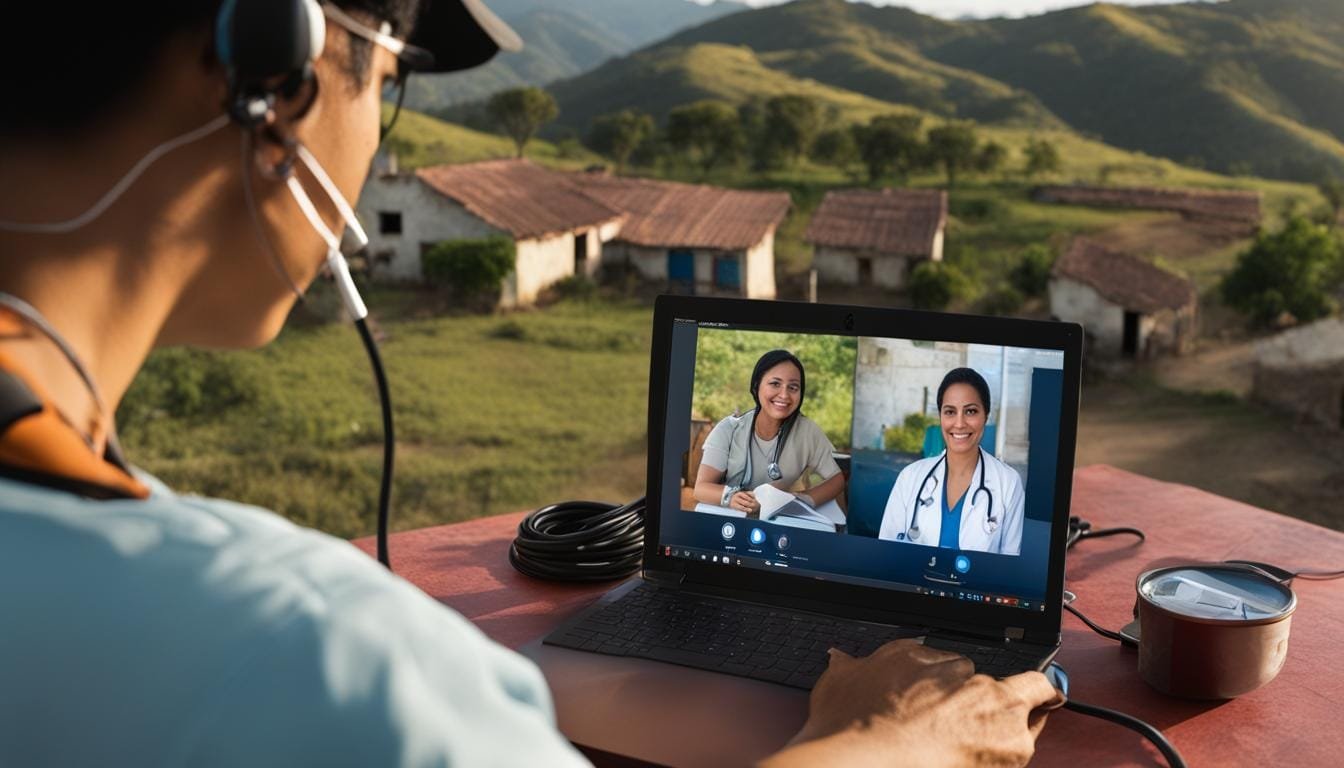Telemedical services have become increasingly popular in Mexico, offering quality care through virtual consultations and remote healthcare options. The rise of telehealth has been particularly significant in the wake of the COVID-19 pandemic, as patients and healthcare professionals alike seek accessible and convenient alternatives to in-person care.
By leveraging telemedicine, hospitals in Mexico have been able to enhance their services, improve accessibility, and reduce waiting times for patients. Telehealth not only provides flexibility and convenience for individuals seeking medical attention but also presents opportunities for the healthcare system to bridge the gap in healthcare access.
While there are challenges, such as limited access to technology, legal and regulatory considerations, and infrastructure limitations, the benefits of telemedical services are clear. From reducing the need for travel to facilitating better coordination between medical disciplines, telehealth offers innovative solutions that can revolutionize healthcare delivery in Mexico.
Key Takeaways:
- Telemedical services in Mexico provide quality care through virtual consultations and remote healthcare options.
- Telehealth has become increasingly popular in Mexico, especially after the COVID-19 pandemic.
- Telemedicine allows hospitals to increase accessibility, improve services, and reduce waiting times for both patients and healthcare professionals.
- Challenges in telehealth adoption include limited access to technology, legal and regulatory considerations, and infrastructure limitations.
- The future of telehealth in Mexico is promising, with advancements in technology and government regulations.
The Benefits of Telehealth in Mexico
Telehealth is revolutionizing the healthcare landscape in Mexico, offering a wide range of benefits for both patients and healthcare providers. With the advancement of telemedicine technology, online medical services are becoming increasingly accessible, convenient, and cost-effective.
For patients, telehealth provides the convenience of receiving medical care from the comfort of their own homes. This is particularly beneficial for those living in remote or underserved areas where access to healthcare facilities may be limited. Telemedicine consultations eliminate the need for long-distance travel, saving time and reducing transportation costs.
Moreover, telehealth bridges the gap between different medical disciplines, allowing for better coordination and collaboration among healthcare professionals. Through virtual platforms, doctors, nurses, specialists, and other healthcare providers can easily communicate, share patient information, and provide comprehensive care.
Healthcare providers also experience significant advantages from implementing telehealth solutions. By leveraging online medical services, providers can streamline administrative processes and reduce overhead costs. Telehealth allows healthcare professionals to expand their patient base without the need for additional office space or personnel.
Additionally, telehealth enables providers to reach a larger population, including patients who may have difficulty accessing traditional healthcare services due to geographical barriers or limited mobility. This plays a crucial role in increasing healthcare accessibility and improving health outcomes for the entire population.
The potential of telehealth in Mexico is immense. It not only offers innovative solutions for delivering quality healthcare but also addresses the challenges faced by the healthcare system, such as long wait times and limited resources. By leveraging telemedicine and telehealth solutions, Mexico can bring quality care directly to patients, enhancing the overall healthcare experience.
To illustrate the impact of telehealth in Mexico, consider the following statistics:
| Statistic | Data |
|---|---|
| Number of teleconsultations conducted in 2020 | 1.5 million |
| Average reduction in travel time for patients using telehealth | 40% |
| Percentage of healthcare providers who reported increased patient satisfaction with telehealth services | 85% |
These figures demonstrate the growing adoption and success of telehealth in Mexico, as well as the positive impact it has on patient care.
With continued advancements in telehealth technology and increased support from the government and healthcare industry, the future of telemedicine in Mexico is promising. Online medical services have the potential to revolutionize healthcare delivery, making quality care more accessible and convenient for all.
Image:
Telehealth in Rural and Underserved Areas
Telehealth plays a vital role in providing healthcare services to rural and underserved areas in Mexico where access to quality care is limited. These communities often face challenges in terms of geographical barriers, lack of medical facilities, and limited transportation options. However, telemedicine platforms have emerged as a lifeline, bridging the healthcare gap and bringing specialist care to patients’ homes.
Virtual consultations through telehealth allow patients in remote areas to connect with healthcare professionals without the need for long-distance travel. This not only saves time and money but also eliminates the geographical constraints that hinder access to specialized care. Patients can receive medical advice, diagnosis, and even treatment recommendations from doctors and specialists, no matter where they are located.
One of the key advantages of teleconsultation is its ability to improve healthcare access and reduce disparities in health outcomes. By leveraging remote healthcare technologies, patients from underserved areas can benefit from expert medical opinion and guidance. This can lead to more accurate diagnoses, timely interventions, and improved overall health outcomes.
The COVID-19 pandemic further emphasizes the importance of telehealth in rural and underserved areas. Social distancing measures prevent face-to-face interactions, making remote healthcare solutions essential for patients in need. Telemedicine enables healthcare providers to remotely assess patients’ conditions, offer treatment recommendations, and monitor their progress, all from a safe distance.
Telehealth has the potential to bring specialized healthcare services to the doorsteps of communities in rural and underserved areas. By breaking down barriers and leveraging technology, telemedicine platforms empower patients and improve their access to quality care.
Telehealth and Government Regulations in Mexico
Government regulations play a crucial role in the implementation and operation of telehealth services in Mexico. The General Health Law was amended in 2020 to include provisions for telemedicine, allowing health professionals to prescribe medication using electronic means. These regulations ensure patient safety, privacy rights, licensing requirements, and reimbursement policies are upheld, providing a solid foundation for the development of telehealth solutions. Additionally, the regulations address interoperability issues, ensuring seamless integration with existing healthcare systems and facilitating the optimization of electronic health records.
| Benefits of Government Regulations on Telehealth in Mexico | Impact on Telehealth Implementation | Key Regulations |
|---|---|---|
| Ensures patient safety and privacy | Creates a secure and trusted environment for telemedicine consultations | – The General Health Law amendment in 2020 – Other relevant healthcare legislation |
| Defines licensing requirements for healthcare professionals | Ensures only qualified professionals provide telehealth services | – Licensing and certification regulations – Qualification criteria and standards |
| Establishes reimbursement policies | Makes telehealth services financially sustainable for healthcare providers | – Reimbursement rates and requirements – Procedures for claims and reimbursement |
| Addresses interoperability issues | Enables seamless integration with existing healthcare systems | – Standards for data exchange and connectivity – Technical requirements for system compatibility |
These regulations provide the necessary guidelines and framework for telemedicine implementation in Mexico. By addressing key considerations and ensuring compliance, they contribute to the success and quality of telehealth solutions in the country. With proper governance in place, healthcare providers can optimize electronic health record management, secure patient information, and offer efficient and effective telemedicine services.
Overcoming Challenges in Telemedicine Adoption
Despite the numerous benefits of telehealth and online medical services, there are significant challenges to the widespread adoption of telemedicine in Mexico. These challenges encompass various aspects such as limited access to technology, legal and regulatory issues, infrastructure limitations, and cultural barriers.
- Limited Access to Technology: In rural and low-income areas, lack of reliable internet connectivity and mobile devices can hinder the participation of individuals in teleconsultations. The digital divide exacerbates the disparities in healthcare access, making it difficult for underserved populations to benefit from remote healthcare services.
- Legal and Regulatory Issues: The implementation of telemedicine requires clear guidelines and regulations to ensure patient safety, privacy rights, licensing requirements, and reimbursement policies. Harmonizing regulations across different regions and addressing legal barriers are essential for ensuring telehealth services meet the necessary standards.
- Infrastructure Limitations: Robust infrastructure is crucial for the seamless delivery of telemedicine services. Adequate bandwidth, reliable connectivity, and secure data transmission are essential for high-quality teleconsultations. Investment in improving infrastructure, especially in remote areas, is necessary to overcome these limitations.
- Cultural Barriers: Promoting digital literacy and addressing cultural beliefs and perceptions are vital for successful telemedicine adoption. Educating individuals about the benefits and reliability of telehealth services and building trust in online medical services are key steps to overcome cultural barriers.
To address these challenges and promote the adoption of telemedicine, Mexico needs to focus on expedited regulatory processes, improved infrastructure, and educational initiatives to promote digital literacy. Interoperability and integration with existing healthcare systems are also critical to ensure a seamless telemedicine implementation.
“Telehealth adoption can significantly improve healthcare accessibility, especially for underserved communities. By addressing the challenges and advancing telemedicine implementation, Mexico can bridge the healthcare access gap and provide quality care to all.”
| Challenges | Solutions |
|---|---|
| Limited access to technology | Investment in infrastructure, providing reliable internet connectivity and mobile devices in rural and low-income areas |
| Legal and regulatory issues | Clear guidelines and regulations, harmonization of standards, and addressing legal barriers |
| Infrastructure limitations | Improving infrastructure, enhancing bandwidth, and ensuring secure data transmission |
| Cultural barriers | Educational initiatives, promoting digital literacy, and building trust in telehealth services |
The Future of Telehealth in Mexico
The future of healthcare in Mexico is rapidly evolving with advancements in technology and the rise of telemedicine. Digital health services and telehealth solutions have the potential to transform healthcare delivery, making it more accessible, efficient, and patient-centered.
Transforming Healthcare Delivery
Telehealth leverages cutting-edge healthcare technology, such as artificial intelligence and advanced medical imaging, to revolutionize patient care. By integrating these innovations, telehealth offers personalized treatments and improves health outcomes. Patients can benefit from remote consultations, eliminating the need for in-person visits and enabling access to healthcare professionals from the comfort of their homes.
With digital health services, telehealth empowers patients to take control of their healthcare journey. Health-tracking applications and online resources provide individuals with the tools and information they need to make informed decisions about their well-being. Telemedicine promotes preventive practices, allowing patients to monitor their health status and engage in proactive healthcare management.
Addressing Challenges for a Bright Future
As telehealth continues to expand, it is crucial to address challenges to ensure its successful implementation. One of the key challenges is the digital divide, which refers to limited access to technology and reliable internet connectivity, particularly in rural and low-income areas. Bridging this divide requires infrastructure development and initiatives to provide affordable technology and internet access to all communities.
Data privacy is another critical concern in the future of telehealth. As healthcare technology advances, it is essential to establish robust security measures that protect patient information and maintain confidentiality. Striking the right balance between data security and accessibility will be vital for building trust and ensuring the widespread adoption of telehealth services.
The Promising Future Ahead
The future of telehealth in Mexico holds immense potential for transforming healthcare delivery and improving patient outcomes. By leveraging digital health services and telehealth solutions, Mexico can bridge the healthcare access gap, especially in underserved areas. With continued advancements in healthcare technology and proactive efforts to address challenges, telemedicine will play a crucial role in shaping the future of healthcare in Mexico.
Conclusion
Tele medical services in Mexico are revolutionizing the healthcare industry by providing quality care through virtual consultations and remote treatment options. With the advancement of technology and the implementation of government regulations, telehealth offers accessibility, convenience, and cost savings for both patients and healthcare providers.
By leveraging telehealth solutions, patients have the opportunity to access healthcare services without the need to travel or face long waiting times. This virtual healthcare approach brings quality care directly to patients’ homes, especially benefiting those in rural and underserved areas.
While challenges exist, such as limited access to technology and legal regulations, the future of telehealth in Mexico looks promising. Innovation in digital health services and concerted efforts to bridge the digital divide will further enhance the adoption and effectiveness of telemedicine. With a focus on proper implementation and addressing barriers, telehealth has the potential to narrow the healthcare access gap and transform the healthcare industry in Mexico.
FAQ
What are telemedical services?
Telemedical services are virtual healthcare solutions that allow patients to receive medical consultations and treatment remotely, using technology such as video calls, messaging, and teleconsultation platforms.
How does telehealth benefit patients and providers in Mexico?
Telehealth offers convenience and accessibility for patients by eliminating the need for travel and reducing costs. It also allows healthcare providers to expand their patient base without additional resources and reduces administrative overheads.
How does telehealth address healthcare access in rural and underserved areas of Mexico?
Telemedicine platforms enable patients in remote areas to receive specialist care through virtual consultations, reducing the need for long-distance travel and providing access to medical professionals in their homes.
What role do government regulations play in telehealth implementation in Mexico?
Government regulations ensure patient safety, privacy rights, licensing requirements, and reimbursement policies. They also address interoperability issues to ensure seamless integration with existing healthcare systems.
What are the challenges to the adoption of telemedicine in Mexico?
Challenges include limited access to technology, legal and regulatory issues, infrastructure limitations, and cultural barriers. Lack of reliable internet and mobile devices in rural and low-income areas can hinder participation in teleconsultations.
What does the future hold for telehealth in Mexico?
With advancements in technology and government regulations, telehealth has the potential to transform healthcare delivery in Mexico, offering innovative and patient-centered solutions to improve health outcomes.



